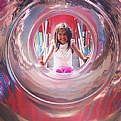
Richard Milner
(K=1653) - Comment Date 11/12/2003
|
The 124G was in production until the mid-80s so late examples are still in very good condition. It also has a built-in lightmeter. Construction is a bit more plasticky than the older TLRs.
Rolleiflexes are generally thought to have better lenses but the difference in price is probably as much due to the snob value as the equipment quality.
On any of these cameras you will tend to get a lot of lens flare if you do not have a hood on the taking lens. Hoods are available secondhand, or I think there are still people making compatible hoods that you can order on-line.
TLRs are great fun. You will love the huge negatives.
|
|
|
|

Chris Lauritzen
(K=14949) - Comment Date 11/12/2003
|
If you want to really play around with a TLR cheaply then look into a Lubitel 166. This is a Russian TLR that goes for about $25 on eBay. It has no meter and can be hard to focus but totally fun to play with and it is capable of taking some fairly sharp images. It takes 120 films.
|
|
|
|

Hugh Sakols
(K=30) - Comment Date 11/12/2003
|
I own a Mamiya c220 TLR. This is an excellent system - I've thought about upgrading to a SLR but am not convinced that it will be better (I shoot landscapes). The Mamiya system has interchangable lenses. I started with an 80mm and later picked up a 55mm and 180mm. I bought the c220 with 80mm lense for $255.00 on ebay 3 years ago.
|
|
|
|

Robert Worthingham
(K=535) - Comment Date 11/13/2003
|
I have used a friend's Yashica D and it gave very nice images. Currently I am using a 45 year old Rolleicord which I picked up used. No interchangable lenses so I'm stuck with the standard wide angle. However, the images are very good and once you have tasted medium format negs, you will be in love forever! The tonal range and colour saturation is so superior to 35mm that it will be hard to go back. Because of the cost of the film and processing, you will find it worth your while to pick up a good light meter (hopefully a spot meter) and learn about Ansel Adams Zone system for exposure. His book, "The Negative" will explain it all and help you become expert at capturing the image you see in your head.
Have fun! I look forward to seeing the fruit of your efforts!
|
|
|
|

Lou Verruto
(K=1375) - Comment Date 11/16/2003
|
Aside from the differences mentioned, the Rolleiflex is built like a tank. All metal body. The Yashicas are mostly plastic, but the taking lens is usually sharp. I have and use a 1961 Rolleiflex. Can't kill it!
Good luck and most of all have fun!
|
|
|
|

Stan Noreika
(K=122) - Comment Date 11/22/2003
|
I'm surprized no one mentioned the Yashica 124. Built better than the G (no plastic), with the same lens and lightmeter. The G meant gold plated contacts for reliability, although I don't think this is a necessity. If I wanted another Yashica, I would just go for the 124. meaning it is capable of using both 120 & 220 film (12 or 24 exposure, clever how they got it into the model number).
I think the Yashicamat is a great bargain(I have one).Some say the lens is inferior, but I'm very satisfied with the results. I've done some great 16x20's that look great.
Also consider the Minolta Autocord. Another great camera (imho)that takes great pictures. I use both, and enjoy them equally.
Good luck, and let us know what you choose.
|
|
|
|

Klaus Mangold
(K=46) - Comment Date 11/30/2003
|
I owned a Yashica some years ago and was very satisfied with this camera. Later I changed to the Mamiya C220 because of the various lenses available. Today I own a C330 with 55mm, 65mm, 80mm, 135mm and 180mm lenses. All is very compact and fits in a quite small camera bag. Excellent for travelling!
|
|
|
|
















